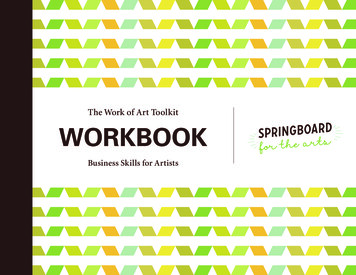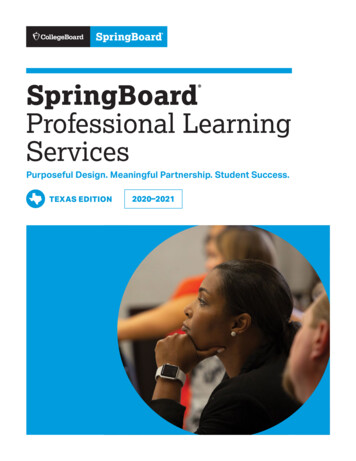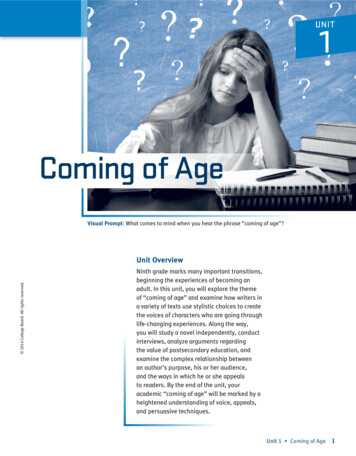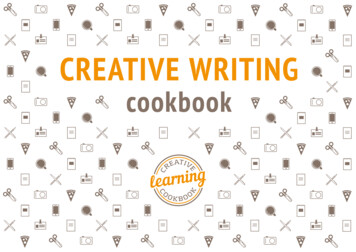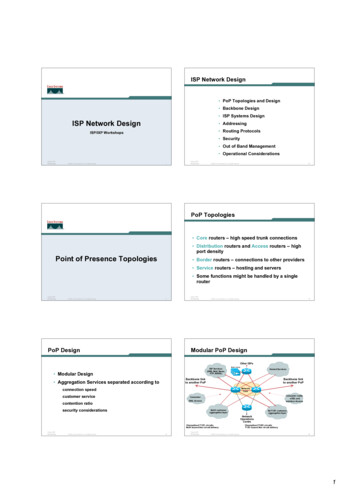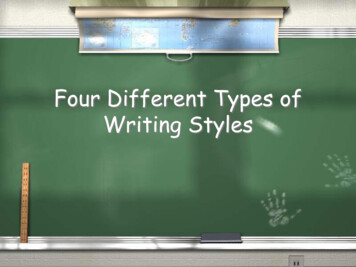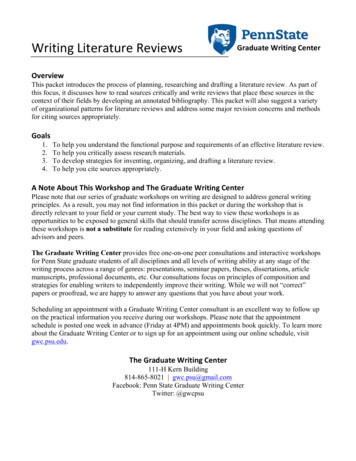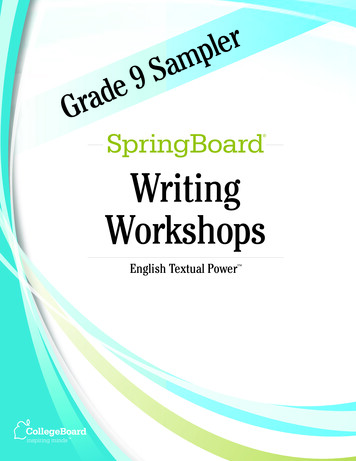
Transcription
relpmaS9edarG SpringBoardWritingWorkshopsEnglish Textual Power inspiring mindsTM
Vertical Articulation of OnlineWriting WorkshopsThe ten SpringBoard writing workshops cover the writing process and major writingmodes. These modes change from middle school to high school to provide distinctions inorganizational structure, style, and writing techniques.Writing Workshop 1 consists of two distinct writing process workshops: one explicitly formiddle school and one for high school. The middle school workshop is designed to introduce and guide students through thestages of the process, helping them to understand and practice writing in each of thestages. The high school workshop assumes that students know the basic skills so they canfocus more on stylistic techniques, rhetorical elements, and syntactical structure thatwriters consider as they move through the various stages of the process.Writing Workshops 2, 3, and 5 include the short story, poetry, and script writing workshops.All have students work from model texts to explore creative writing modes. As students movethrough the workshop levels, they develop more independently through continued creativewriting opportunities.Writing Workshop 4 begins with personal narrative writing in middle school and moves intoreflective writing in high school to help prepare students for the kind of writing they will needto become college ready.Writing Workshop 6 consists of expository workshops that allow students to explore a varietyof organizational structures, such as cause-effect, compare-contrast, problem-solution,definition, and synthesis.Writing Workshop 7 includes procedural writing workshops, which give students practicein practical writing applications that develop writing skills appropriate for the workplace andcollege.Writing Workshop 8 focuses on persuasive writing and moves through two distinctorganizational structures that ultimately prepare students for end-of-course exams and AP.The middle school workshops focus on persuasive essays, whereas high school workshopsfocus on AP prompts that prepare students to transfer the elements of persuasive writing tomore sophisticated elements of argumentation.Writing Workshop 9 has students analyze texts and write a response to a literary orexpository text. These workshops allow students to analyze both fiction and nonfiction textsand write thoughtful responses analyzing the elements of each. The model texts analyzedrange from short stories to poetry and expository texts.Writing Workshop 10 includes research to introduce, reinforce, and refine research processskills, collaborative skills, and evaluation of results. Students produce an expository textreporting the results and their interpretation of their research and its application to a specifictopic.
SpringBoard Writing WorkshopsEnglish Textual Power This Grade 9 sampler contains Writing Workshop 8, Persuasive Writing: Argumentation Writing Workshop 9, Response to Literary or Expository TextSpringBoard instruction in writing is addressed in two integrated ways: through projectbased, scaffolded writing assessments and through SpringBoard Online Writing Workshops.Writing Workshops offer teachers and students guided experiences in specific rhetorical andgrammar and usage skills, emphasizing practice and mastery of specific writing modes. WritingWorkshops are designed to offer additional direct writing instruction to support and extendmastery of the writing process and commonly assessed written products. Each workshop guidesstudents through the writing of three separate texts in the specific mode being taught: one thatis constructed as a class with direct guidance from the teacher, one that is peer constructed withteacher support, and one that is written independently.Ten different writing workshops are available on SpringBoard Online for each grade level fromgrades 6 through Senior English. The workshops for each level cover the following writing modes:Writing Workshop Genres, Grades 6–12: Writing Workshop 1: The Writing Process Writing Workshop 2: Short Story Writing Workshop 3: Poetry Writing Workshop 4: Personal Narrative (or Reflective Essay) Writing Workshop 5: Script Writing Writing Workshop 6: Expository Writing Writing Workshop 7: Procedural Texts Writing Workshop 8: Persuasive Writing Writing Workshop 9: Response to Literary or Expository Text 2011 College Board. All rights reserved. Writing Workshop 10: ResearchThe SpringBoard Writing Workshops are closely aligned to state and CommonCore writing standards. These workshops help prepare students to write well ina variety of writing modes that are key to college readiness and to success onhigh stakes assessments such as end-of-course exams, AP tests, and the SAT.Copyright 2011 The College Board. All rights reserved.College Board, Advanced Placement Program, AP, AP Central, AP Vertical Teams, College Ed, Pre-AP, Springboard, connectingto college success, SAT, and the acorn logo are registered trademarks of The College Board. College Board Standards forCollege Success, connect to college success, English Textual Power, and SpringBoard are trademarks owned by CollegeBoard. PSAT/NMSQT is a registered trademark of The College Board and National Merit Scholarship Corporation. All otherproducts and services may be trademarks of their respective owners.
WritingWorkshop 8SUGGESTED LEARNING STRATEGIES: Close Reading, Brainstorming,Think-Pair-Share, Drafting, Summarizing, Graphic Organizers, DiscussionGroups, Peer Editing, Sharing and RespondingMaterials: 3 x 5 note cards 2009, AP Language andComposition, Question 3 SampleResponse 3 B from AP CentralFocus:The purpose of persuasive writing is to influence readers’ attitudes to persuadethem to agree with the writer or to take action on issues the writer describes.Effective persuasion involves clearly identifying issues, anticipating and respondingto objections, presenting support for a position, and using sound reasoning to helpconvince the audience.Focus:Goal:Students will create three separatetexts through this series of steps:one that is co-constructed as aclass with direct guidance fromthe teacher, one that is peerconstructed, and one that is writtenindependently.To write argumentative essays for appropriate audiences that: A clear thesis or position based on logical reasons supported by precise andrelevant evidence. Consideration of the whole range of information and views on the topic, andconsideration of accurate and honest representation of these views. Counter-arguments based on evidence to anticipate and address objections. An organizing structure appropriate to the purpose, audience, and context. An analysis of the relative value of specific data, facts, and ideas.To achieve this goal, you will engage in a series of activities in which you work withyour teacher and with your classmates to construct two persuasive essays. You willthen use these models for your own writing.TEACHER TOTEACHERThis workshop uses aprompt from a releasedAP Language and Compositionexam. For your reference you canfind a sample student responselocated at apcentral.collegeboard.com. Go to AP Courses andExams and then click on ExamQuestions, then find APLanguage and Composition.You can then select the appropriateyear and question. This sampleresponse (3B) can be used atvarious points during this lesson tomodel the elements of anargumentative essay.Activity 1: Discovering the Elements of an Argumentative EssaySample TextThe following paragraphs are from the 2009 AP Language and Composition Exam(Question 3).Adversity has the effect of eliciting talents which in prosperous circumstances wouldhave lain dormant. –HoraceConsider this quotation about adversity from the Roman poet Horace. Then writean essay that defends, challenges, or qualifies Horace’s assertion about the role thatadversity (financial or political hardship, danger, misfortune, etc.) plays in developinga person’s character. Support your argument with appropriate evidence from yourreading, observation, or experience.2. Your teacher will provide a sample student response to the preceding prompt.With your class, read the sample response, paying close attention to the thesis,the evidence used to prove the thesis, and the student’s commentary about theimportance or significance of the evidence.Steps:Activity 1: Examining the Elementsof an Argumentative Essay1 Activate students’ priorknowledge about responding toa prompt. Deconstruct the promptwith your students and have themsummarize the task.2 Place the three possibleresponses on the board. Spendtime discussing the terms defend,challenge, and qualify. Add these newterms to your persuasive WordWall.54SpringBoard English Textual Power Level 4Persuasive Writing: Argumentation 2011 College Board. All rights reserved.Persuasive Writing:Argumentation54SpringBoard English Textual Power Level 43 Students are ready to do ashared reading of the samplestudent response (Response 3B) tothe 2009 AP Prompt, Question 3.Do a close reading of theresponse, paying most attentionto the thesis, examples andcommentary. Note: Examples fromstudent sample response 3B includepersonal experiences and the novelThe Grapes of Wrath. 2011 College Board. All rights reserved.Writing Workshop 8
Writing Workshop 8WritingWorkshop 8ContinuedcontinuedSteps:Activity 2: Writing a ClassConstructed Argumentative EssayActivity 2: Writing a Class-Constructed Argumentative EssayPrompt: As a class, write an essay that responds to the prompt listed in the SampleText. Your class-constructed essay should meet the requirements given in the goalstatement for essays of argumentation.TEACHER TOTEACHERAs with all classconstructed texts, the keyis allowing students to visuallyrepresent their ideas, discuss prosand cons, and manipulate theseideas into a class-constructed text.4 Encourage students to beginbrainstorming texts, experiences,and examples that could be usedto respond to this prompt. It isimportant to note that they havenot yet made a choice on whichposition to take. The examples willhelp them do this.1. Read the prompt in the Sample Text. There are three possible positions or claimsyou can assert:Defend: You agree that adversity brings out talents that otherwise might havebeen undeveloped.Challenge: You disagree and believe that adversity does not bring out talentsthat might otherwise have gone undeveloped.Qualify: You see and understand the validity of both sides, but believe one hasmore validity than the other.2. In the space provided, brainstorm texts, experiences, and examples that could beused in response to the prompt. At this point, your examples could be used forany or all of the above choices.5 Instruct students to think-pairshare their ideas with a partner.Have them choose the two or threemost precise and relevant examplesto share with the class.6 Once all groups have reportedout, discuss the range of views andexamples. Evaluate which categoryhas the most logical and relevantevidence and draft a thesis for theclass-constructed essay. 2011 College Board. All rights reserved.3. Once you have brainstormed your list, choose the two or three most preciseand relevant pieces of evidence to support one of the three claims. Write thisevidence on the board.4. After everyone has submitted evidence, you will have collected a solidrepresentation of a range of views and information. As a class, evaluate whichposition has the most logical, precise, and relevant evidence, and draft a thesisfor your class-constructed essay.55 2011 College Board. All rights reserved.Writing Workshop 8 Persuasive Writing: ArgumentationWriting Workshop 8 Persuasive Writing55
Writing Workshop 8ContinuedWritingWorkshop 8Persuasive Writing: ArgumentationcontinuedSteps:7 Introduce the concept of ethosYour class should now have a clear and thoughtful thesis/position statement, as wellas a list of specific and relevant evidence. The next item to consider is the credibilityand authenticity, or ethos, of the speaker.by asking students to summarizethe definition. Add the term to yourpersuasive Word Wall. Reviewevidence from your class brainstormand identify ethical appeals. If noneis apparent, work as a class to addevidence that reflects the qualityand character of the speaker.8 Place students into smallgroups and ask them to createmanipulative cards for all theevidence in support of their claim.(Each piece of evidence shouldhave a card.) On each card, instructstudents to write an L, E, or P tocorrespond to the evidence’s logical(logos), emotional (pathos), orethical (ethos) appeal. Evaluate thebalance of the class’s evidence andadd or subtract as needed.5. Read and summarize or paraphrase the following definition of ethos:Ethical appeals, or ethos, attempt to persuade the reader or listener by focusingon the qualifications or the character of the speaker. The speaker’s credibilityis paramount in an ethical appeal. Ethical appeals depend on the speaker evenmore than on the situation. Examples of ethical appeals in advertising are expertor celebrity endorsements of products. The experience of the speaker may alsoqualify him or her as credible. Other examples of ethical appeals are a teen’sargument that he or she should be allowed to do something because he or she istrustworthy and has never been in trouble.6. Review the class collections of evidence and identify any possible ethicalappeals. If none has been identified yet, make sure you add evidence that can beaccurately and honestly submitted that reflects the quality and character of thespeaker.7. In order to rank the relative value of the evidence you have, begin by making acard for each of the items of evidence that you have developed as a class. Oneach card, label the corner with an L, E, or P (Logos, Ethos, and Pathos). Is therea balance between logical, emotional and ethical evidence? If not, brainstorm asa class what possible evidence you could add.9 Discuss the term relative valueTEACHER TOTEACHERA Comment about EssayForm: For many beginningwriters, a tightly organized essaystructure is a trustworthy way tobegin. However, once students havelearned the basic tenets of essayorganization, consider encouragingthem to develop their ownorganized "style" for presenting ideas.56SpringBoard English Textual Power Level 4Organizing the Essay9. Now it is time to organize your evidence into confirmation paragraphs. Use theappropriate organizational structure (below) to draft your paragraphs. Thenshare your results to create the class-constructed essay. Draft your confirmationparagraphs on separate paper. Sentence 1: Topic Sentence: Statement of a reason to support your thesisclaim. Sentence 2: Evidence: Examples to support the claim (facts, details, stories,etc.). Sentence 3: Commentary: Explanation of the significance of the evidence orthe connection to the claim. Repeat sentence types 2-5.56SpringBoard English Textual Power Level 4 2011 College Board. All rights reserved.with your students. Have studentsuse their manipulative cards toplace the evidence in order of itsrelative value. This will help transitionto the next step of organizingparagraphs.0 You can use the suggestedorganizational structure or anorganizational structure of yourown to help move your studentsfrom a list of evidence to cohesivesupportive paragraphs. The focushere is on the connection betweentopic sentence, evidence, andcommentary. Use the sample text forreference. Have students draft andshare their ideas and then createclass paragraphs. 2011 College Board. All rights reserved.8. Once your cards are complete, organize them according to their relative valueby asking focus questions. In other words, for the purpose of this particularessay, are opinions more important than facts? Would some of the evidenceyou brainstormed resonate more with a particular audience? In the context of aformal essay, how important is the speaker?
Writing Workshop 8WritingWorkshop 8ContinuedcontinuedSteps:a Ask students to create a10. The steps you just went through to create your confirmation paragraphs areessential to a well-balanced argumentative essay. For review, those steps were:graphic organizer to identifytwo or three pieces of evidencethat could be used as a counterargument. You should already haveideas listed on the board from youroriginal brainstorming session.b On the graphic organizer,ask students to point out theweaknesses and/or argue that theclass claim is more valid. Revisitthe class construction process anddevelop a quality paragraph forconcessions and refutations.c Review the elements of a strongconclusion and have students draftindividual conclusions. Collectstudent samples and then constructone together.Step 1: Brainstorm evidence and create a workable thesis.Step 2: Identify the most logical and relevant evidence for your position.Step 3: Review for a balance of appeals (logos, ethos, and pathos).Step 4: Analyze the relative value of the evidence.Step 5: Organize your paragraphs considering the purpose, audience, andcontext of the essay.11. The counter-argument must be presented to show you acknowledge otherpoints of view. On a separate piece of paper, use an appropriate graphicorganizer to identify two to three pieces of evidence that could be used in acounter-argument. For each piece of evidence, point out the weaknesses or arguethat your claim is more valid. When you are done, report to the class, select acounter-argument, and add it to the class-constructed essay.12. As a final step, draft a conclusion in the space provided. Use ideas from yourdraft to help create a class-constructed conclusion.Activity 3: Creating a Peer-Constructed Argumentative EssayPrompt: Working within groups, your task is to respond to the prompt in the SampleText. Your collaborative essay should take the opposing view of the class-constructedessay. Be sure your essay meets the requirements listed in the goal statement forargumentative essays.d Model using the Revision 2011 College Board. All rights reserved.1. In writing groups, review the writing steps from the class-constructedargumentative essay and apply them as you create your peer-constructedargumentative essay.Checklist on the next page withthe class-constructed essay. Havestudents reflect on their ownunderstanding of the process ofwriting this persuasive essay.e Use the reflections to check forunderstanding and plan mini-lessonsto address common questions andconcerns as needed.2. Upon completing your essay, exchange essays with another group and evaluateand provide feedback for that group’s essay, based on criteria established in thegoal statement. Use the revision checklist on the next page to guide your work.3. Revise your essay based on feedback. Edit your essay for proper languageconventions, and make it ready for publication. 2011 College Board. All rights reserved.Writing Workshop 8 Persuasive Writing: Argumentation57Activity 3: Creating a PeerConstructed Argumentative Essayf From within discussiongroups, assign students to pairs. Asthe pairs follow a similar processfor writing an argumentative essay,facilitate their process and monitortheir progress. Clarify students’understanding as needed.g When students have completedtheir essays, facilitate the peerediting process by encouragingstudents to use the RevisionChecklist and review the targetsoutlined in the original goal.h After pairs have receivedfeedback from another pair viasharing and responding, checkfor understanding and providesupport as students prepare forwriting an argumentative essayindependently.Writing Workshop 8 Persuasive Writing57
Writing Workshop 8ContinuedWritingWorkshop 8Persuasive Writing: ArgumentationcontinuedSteps:Activity 4: IndependentArgumentative WritingPersuasive Essayi Assign the independent writingprompt, providing support asneeded during the writing process.1. Issue/Topic Are there multiple viewpointssurrounding this issue?2. Claim Does the claim have a topic andopinion? Does the writer give reasons formaking the claim?3. Support What facts, statistics, examples, andpersonal experiences are used? Does the writer use sound reasoningand relevant details? Is the evidence relevant, accurate,current, and typical?4. Audience To whom do the reasons, evidence,appeals, and examples seem to betargeted? Are the above appropriate for theintended audience?5. Opposing Viewpoints Does the writer address opposingviewpoints clearly, fairly, andcompletely? Does the writer acknowledge andrefute opposing viewpoints with logicand relevant evidence?6. Conclusion Does the writer conclude theargument effectively? 2011 College Board. All rights reserved.Revision Checklist(Adapted from The AP Vertical Teams Guide for English)Activity 4: Writing an Argumentative Essay IndependentlyPrompt: Your task is to defend, challenge, or qualify the following quote:“What’s money? A man is a success if he gets up in the morning and goes to bed atnight and in between does what he wants to do.” – Bob DylanUse the examples, process, goal, and revision steps from your previous activities toaccomplish your task. Your essay should meet the requirements listed in the goalstatement for argumentative essays.SpringBoard English Textual Power Level 4 2011 College Board. All rights reserved.5858SpringBoard English Textual Power Level 4
Persuasive Writing: ArgumentationWritingWorkshop 8SCORI NG GUI he writer’s compositiondoes the following:The writer’s compositiondoes the following:The writer’s compositiondoes the following: asserts a sophisticatedand well-defined thesis orposition presents a thesis orposition presents no thesis orone that is not focusedon the issue includes detailed evidenceand authoritativecommentary that iseffectively organizedto support the writer’sviewpoint uses research andevidence effectively tomake a clear distinctionbetween fact and opinion demonstrates effectiveanalysis of data andideas exemplifiedthrough inclusion ofrelevant support forthe thesis and effectivecounterarguments includes evidence,examples, andreasoning that areorganized to supportthe writer’s viewpoint makes a distinctionbetween fact andopinion demonstrates analysisof data and ideasexemplified throughrelevant support forthe thesis and effectivecounterarguments anticipates andaddresses readers’concerns andcounterarguments. includes some evidenceand commentary thatmay not be relevantand/or does notsupport the argument fails to make a cleardistinction between factand opinion fails to exemplify ananalysis of data andideas for relevancy tothe thesis does not anticipateand/or addressreaders’ concerns andcounterarguments. thoroughly anticipates andanswers readers’ concernsand counterarguments. 2011 College Board. All rights reserved.OrganizationalStructureThe persuasive compositionis coherent and exceptionallyorganized to support theauthor’s viewpoint. Itmaintains consistent focusand includes the following: an engaging introductionwith an effective hook andstrong thesis clearly follows thestructure for persuasivewriting with wellsupported bodyparagraphsThe persuasivecomposition is coherentand organized to supportthe author’s viewpoint.It maintains consistentfocus and includes thefollowing: an introduction with astrong hook and clearthesis body paragraphs thatsupport the thesis an effective conclusionwith a call to action.The persuasivecomposition lackscoherence, is unfocused,and is difficult to follow.Some or all of thefollowing are missing: an introduction withan effective hook andthesis supportive bodyparagraphs a conclusion and/or callto action. provides an insightfulconclusion that contains aclear call to action.Unit 2 What Influences My Choices?58a
WritingWorkshop 8Persuasive Writing: icientEmergingPersuasiveTechniquesThe composition skillfullyuses persuasive languageand appeals that effectivelyadvance the argument,supports the writer’s purposeand context, and considersthe particular audience.The composition considersand addresses multipleviews while also skillfullyanticipating and alleviatingreaders’ concerns.The composition usespersuasive language andappeals that supportthe thesis and writer’spurpose and context andaddress the intendedaudience. The compositionconsiders other opinionsand anticipates andaddresses readers’concerns.The composition attemptsto use persuasivelanguage and/or appealsfor a specific purpose,context, and audience,but the appeals may bevague and/or repetitive.The composition fails toinclude a variety of viewsand does not adequatelyaddress readers’ concerns.WritingProcessThe compositiondemonstrates use of thewriting process throughits clear organization,internal and externalcoherence, variety ofsentence structures, effectivetransitions, avoidance ofrepetition and extraneousinformation, and few, if any,errors.The compositiondemonstrates the writingprocess through its clearorganization, coherence,use of varied sentencestructures, transitions,and lack of repetition andextraneous information.The composition maycontain some errors thatdo not detract from theoverall presentation.The compositionprovides little or noevidence of followingthe writing process andcontains problems withorganization, coherence,use of varied sentencestructures, transitions, andrepetitive or extraneousinformation.ConventionsThe composition containsfew or no errors in grammar,spelling, punctuation, orcapitalization.The composition maycontain some minorerrors in grammar,spelling, punctuation, orcapitalization that do notdetract from the work.The compositioncontains multipleerrors in grammar,spelling, punctuation, orcapitalization that detractfrom the quality of thework.AdditionalCriteria:Comments:58b SpringBoard English Textual Power Level 4 2011 College Board. All rights reserved.SC ORI NG GUI DE
Response to Literary orExpository TextWriting Workshop 9WritingWorkshop 9Response to Literary orExpository TextResponse to Literature: Short StorySUGGESTED LEARNING STRATEGIES: Quickwrite, Close Reading,SIFT, Think Aloud, Free Writing, Marking the Text, Graphic Organizer,Questioning the Text, Notetaking, Think-Pair-Share, Brainstorming,Webbing, Outlining, Drafting, Sharing and RespondingFocus: Short StoryThis sequence of activities isdesigned to provide direct writinginstruction. Students will createthree separate essays through thisprocess: one that is co-constructedas a class with direct guidancefrom the teacher, one that is peerconstructed, and one that is writtenindependently.Focus:The purpose of a response-to-literature essay is to demonstrate thoughtfulunderstanding of a literary passage. The writer crafts an analysis of the text and theauthor’s stylistic technique and supports it with textual evidence to convey meaningto the reader.Goal:Write a multi-paragraph response-to-literature essay that: Presents effective introductory and concluding paragraphs.Connection to EmbeddedAssessments:This workshop provides additionalscaffolding for Level 4, Unit 2,Embedded Assessment 2, Writinga Style Analysis Essay: Unit 3,Embedded Assessment 2, Analyzingand Presenting a Poet; and Unit 5,Embedded Assessment 2, Analyzinga Passage in To Kill A Mockingbird. Analyzes literature and extends beyond a summary or literal analysis. Contains a controlling idea or thesis. Provides evidence from the text using embedded quotes. Analyzes the aesthetic effects of an author’s use of stylistic or rhetorical devices. Includes relevant information and valid inferences. Uses an organizing structure appropriate to purpose, audience, and context. Uses a variety of rhetorical devices. Uses transitions between paragraphs. Uses a variety of sentence structures. 2011 College Board. All rights reserved.To achieve this goal, you will engage in a series of activities in which you work withyour teacher and with your classmates to construct two model essays. You will usethese models to write your own essay.Steps:Activity 1: Discovering Elements of a Multi-ParagraphResponse-to-Literature Essay1. Quickwrite: Describe the purpose, organization, elements, and possibleaudiences of a response-to-literature essay. Describe your past experienceswriting in this genre. 2011 College Board. All rights reserved.Writing Workshop 9 Response to Literary or Expository Text59Activity 1: Discovering Elementsof a Multi-Paragraph Response-toLiterature Essay1 To activate students’prior knowledge have studentsrespond to the quickwrite. Solicitresponses and chart them on theboard. Preview the goal of thiswriting workshop.2 Ask students to generate alist of an essay’s organizationalcomponents (introduction, thesis,body, conclusion, transitions)and characteristics (key issues,textual evidence, commentary).Chart responses on the board.Co-construct a graphicorganizer of the components andcharacteristics of a multi-paragraphresponse-to-literature essay that canbe used to plan during the writingprocess of their own essay.Writing Workshop 9 Response to Literary or Expository Text59
Writing Workshop 9ContinuedWritingWorkshop 9continuedResponse to Literary or Expository TextResponse to Literature: Short StorySteps:3 Use close reading to make2. Conduct a close reading of Liliana Heker’s short story “The Stolen Party.” Whilereading, mark the text for elements of SIFT in order to analyze how the authoruses symbolism, imagery, figurative language, and tone to convey theme. Youare preparing to write a response-to-literature essay.meaning from Liliana Heker’s shortstory, “The Stolen Party,” located inSpringboard, Level 4, page 110. Usea think aloud to help studentsanalyze the text with the SIFTstrategy. Guide students throughthe process of extending beyond aliteral understanding by conductinga deeper analysis of theme aswell as the effects of an author’suse of literary devices to conveymeaning. Encourage students tomark the text and take noteson supporti
54 SpringBoard English Textual Power Level 4 SB_TX_G9_Sampler.indd 54 1/13/11 4:54 PM. continued Writing Workshop 8 Activity 2: Writing a Class-Constructed Argumentative Essay Prompt: As a class, write an essay that responds to the prompt listed in the Sample Text. Your class-constru
